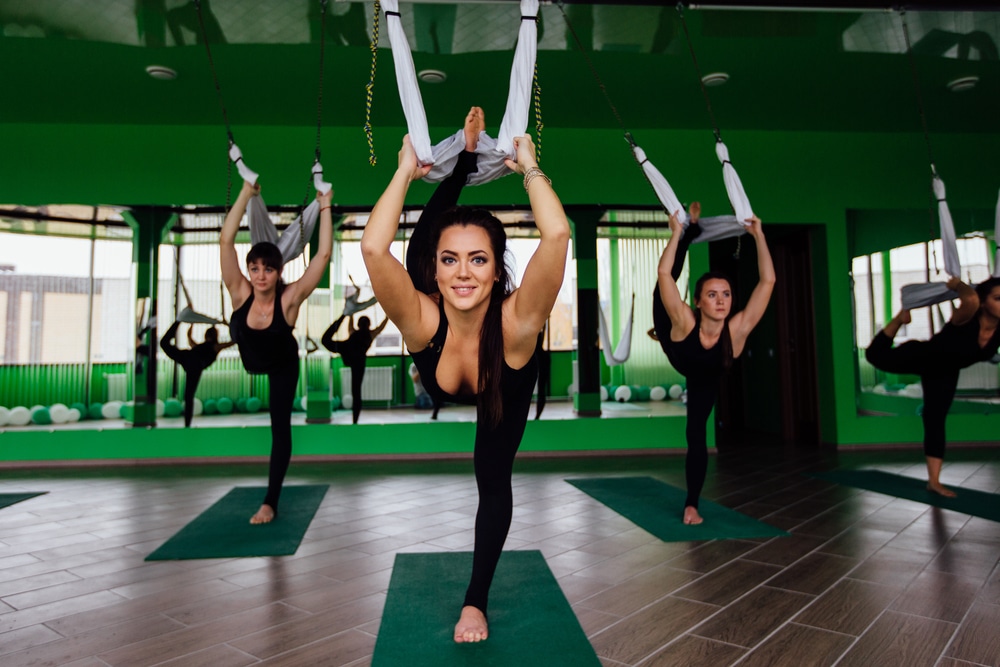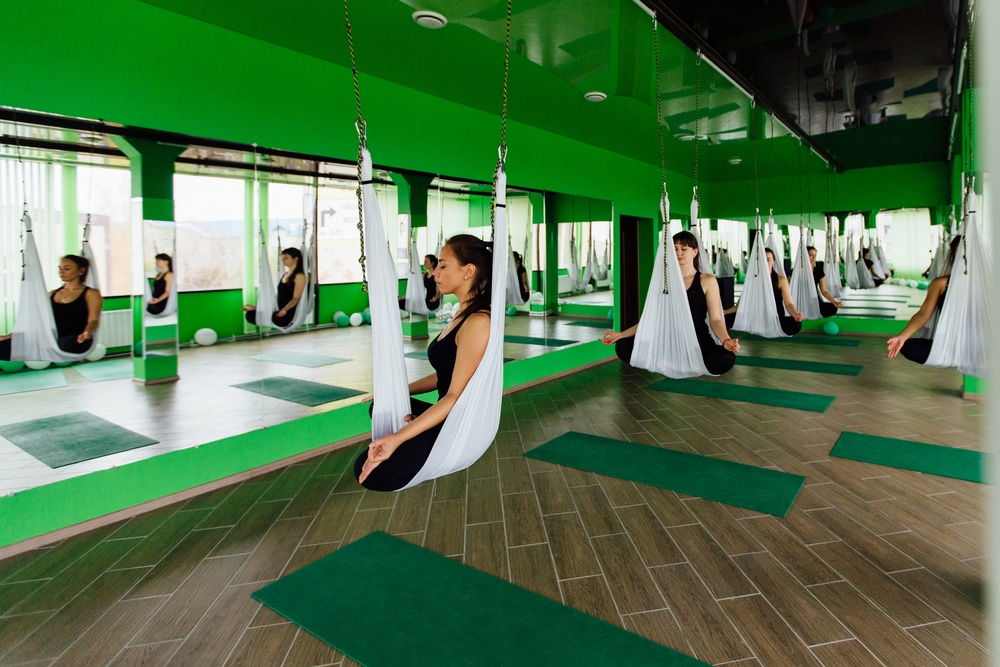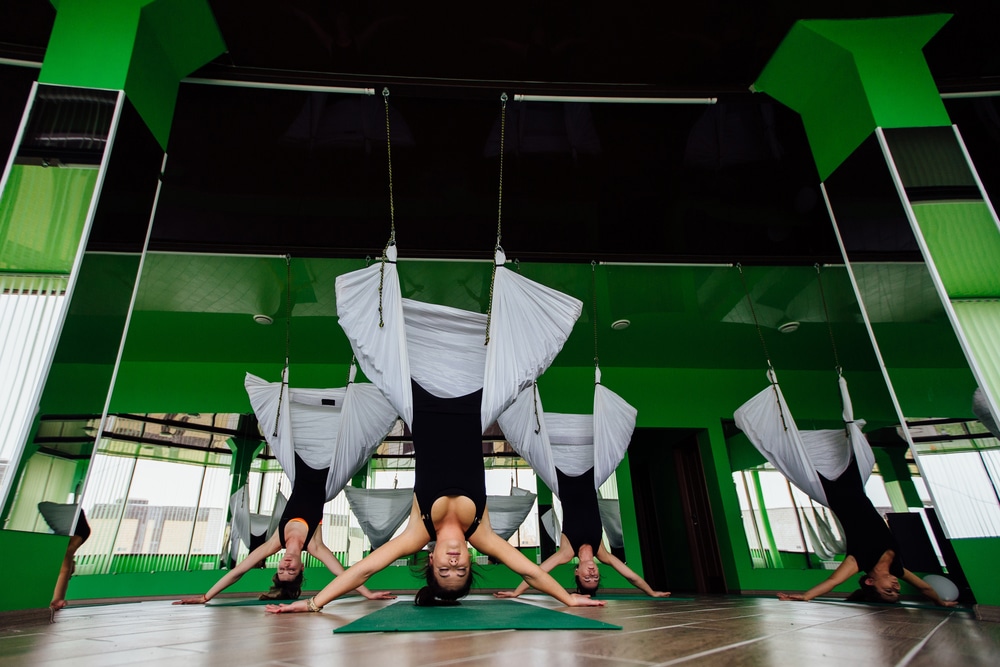The practice of yoga originated thousands of years ago, and it’s been steadily evolving ever since.
From styles like one of the most traditional forms, Ashtanga, or something a bit more modern like Bikram, to power vinyasa classes and everything in between, yoga continues to flourish and expand in many directions.
Those who practice yoga regularly are likely familiar with different types such as AcroYoga or aerial yoga.
Both AcroYoga and aerial yoga can allow for a little bit more creativity and add an artistic vibe to the practice.
Though not traditional forms of the practice, these types can certainly provide the practitioner with some different benefits to what you might typically find in taking a class on the mat.
While all you need for AcroYoga is a partner and a decent amount of strength and flexibility, in order to practice aerial yoga you’ll need the right equipment.
Yoga swings are used to get the practitioner lifted and add an anti-gravity quality to the practice.
So what is a yoga swing? What are the benefits of practicing aerial yoga?
Can yoga swings relieve back pain? What are some exercises on the yoga swing that you can incorporate into your own life—even if you’re a beginner?
Keep reading to learn all about the yoga swing, and you’ll be taking flight in no time!
What Is Aerial Yoga?
 If you’ve ever in your life wished to fly, now is your chance!
If you’ve ever in your life wished to fly, now is your chance!
Whether you practice yoga already or not, there’s a good possibility that you’ll love aerial yoga. Essentially, it’s an anti-gravity form of yoga.
You can practice many of the same poses—or slightly modified variations of the poses—but in the air instead of on the mat!
Hammocks typically made out of high-density nylon material are used to get you lifted and flying.
There are many aerial yoga studios that will already have a set up with hammocks attached to the ceiling with carabineers and support chains.
However, many avid aerial practitioners actually have a setup for a yoga swing in their own homes!
What Is a Yoga Swing? What Is the Purpose of a Yoga Swing?
 A yoga swing can also be referred to as a yoga trapeze, silks—though not typically made of silk at all, a yoga hammock, or hanging ropes.
A yoga swing can also be referred to as a yoga trapeze, silks—though not typically made of silk at all, a yoga hammock, or hanging ropes.
This piece of equipment is ultimately just a really great inversion tool.
At an aerial yoga studio, yoga swings are typically in a large room with plenty of space for movement.
If you’re considering getting a yoga swing for your home, a good spot for the swing would be in a spare or unused room, a garage, a door frame—this can be a little tough due to limited space, or even hanging from a tree outside.
All in all, the purpose of using a yoga swing or practicing aerial yoga is just for fun!
The benefits of the practice, however, can make it an even more desirable activity to get involved in.
Yoga swings are designed to help the practitioner get off the ground and find that anti-gravity quality.
Yoga swings are typically close to the ground—the bottom of the swing is usually a meter or so away from the earth.
Because of this, yoga swings do a fantastic job of helping to support the lower back in backbends and the hips in forward folds, as well as in many other postures.
So Where Did This Practice Even Come From? What Is the History of Aerial Yoga and the Yoga Swing?
 Somewhat resembling something you’d see in a circus performance, aerial yoga came about—or at least was greatly popularlized—by the early 2000s.
Somewhat resembling something you’d see in a circus performance, aerial yoga came about—or at least was greatly popularlized—by the early 2000s.
A former circus performer, Christopher Harrison, actually developed the concept.
Harrison originally used the swing to stretch before performances and found so many benefits such as decompressing the spine and increasing blood flow to the brain.
The beauty of aerial yoga is that it can be incredibly gentle and restorative, bringing relief to tense areas of the body, or it can be invigorating and powerful as you fly through the air like a bird!
Like traditional yoga, the aerial practice is whatever you make of it.
What Are the Benefits of Using a Yoga Swing?
While aerial yoga can have many of the same benefits as the traditional asana—physical—practice of yoga, there are also tons of additional benefits to practicing aerial yoga.
Essentially, the benefits you would find while practicing on the mat are heightened and exaggerated while using the swing.
Stress relief is a huge benefit to practicing aerial yoga. This works much in the same way as a traditional yoga practice would relieve stress.
Connecting with the breath and feeling it move through the body settles the mind in an incredible way. For many, being lifted off of the earth and enjoying the feeling of floating can provide an even greater sense of calm throughout the body.
Increased focus is also an amazing benefit to the practice. Because you’re in the air, many of the postures can be perceived as a bit more difficult than they would be on the ground.
Through this challenge, even more focus is required to keep the body engaged instead of swinging around wildly in the air.
In order to stay stable while using the yoga swing, your core has to remain engaged. While finding poses in the air, your muscles will strengthen in ways you may not have ever known existed!
When coming into a pose on your mat, you’re able to use the earth for leverage. When you’re in the air, however, gravity is working against you and it’s up to your own body strength to make something happen.
Because you’re floating freely in the air with the yoga swing, there’s more possibility to go even deeper into some postures. T
hough aerial yoga is fantastic for those who aren’t overly flexible, the yoga swing can allow even more range of motion to go deeper into postures and get a more fulfilling stretch, which can feel amazing—particularly if you already have a lot of flexibility in your body.
Perhaps one of the most important benefits of practicing aerial yoga is increased spine health and spinal decompression.
Whether we spend lots of time sitting, standing or walking during the day, the spine endures quite a bit of compression. Using this anti-gravity approach can help release tension throughout the spine and neck.
Can a Yoga Swing Relieve Back Pain?
Using a yoga swing can absolutely help to relieve back pain. It’s actually been shown that hanging upside down can help reduce pain in the spine as it allows space to be created between the vertebrae, releasing pressure and tension built up over time.
It is important to be mindful not to remain upside down for long periods at a time, as it can be risky for someone with high blood pressure or vertigo.
Not only can it relieve pain and tension through the spine and neck, but it can also increase blood flow to the brain and help energize blood cells.
Consider how practicing a headstand on the floor can cause tension through the neck.
Though the idea of a headstand is to actually be able to press into the forearms and lift all of the weight off of the top of the head, many people—new and seasoned practitioners alike—struggle with that, which can be incredibly dangerous for your neck.
Practicing inversions on the yoga swing can help you find the pose in your body while also keeping your head, neck and back safe.
Additionally, through strengthening your core muscles, you also strengthen your spine.
So whether you’re hanging upside down decompressing the spine or you’re practicing an invigorating sequence engaging all of the muscles of the core, you’re helping your back in one way or another!
What Are the Best Yoga Swings?
There are many different brands and types of yoga swings available. The most versatile options come with a yoga hammock as well as detachable straps with handles.
Others include only the fabric hammock, though for many people this is all they need or want. It’s completely a personal preference on which style you go with!
While many people appreciate the versatility of the handles, other practitioners feel they get in the way and would prefer to practice with just the fabric hammock.
YOGABODY, UpCircleSeven, and Wellsum all make great options that typically hold anywhere from 300lbs to 600lbs. The brand Getting Inverted also makes beautiful colorful, tie-dye yoga hammocks that are fantastic quality.
What Are Some of the Best Yoga Swing Exercises for Beginners?
There are so many incredible things you can do with the yoga swing. It’s important to remember there are plenty of options for each level of experience.
If something doesn’t feel good, back out of the pose and try it a different way or try something else entirely.
Check out these 6 poses that are great for beginners as well as for those who’ve been practicing with their yoga swings for some time!
- Lay back in the cross position. An incredibly relieving posture is to simply lie back across the hammock. Let the swing rest underneath your ribs with the arms splayed out and the legs straight out in front, feet rested on the earth. This is a deep heart opening posture that can help open the chest, shoulders, and abdomen, which can improve your posture and relieve stress.
- Chair in the cross position. Slide the swing underneath both armpits and slowly sink down into a chair position with the legs. Your hands can rest on your thighs. This position is incredibly relieving for the spine, releasing tons of compression through the vertebrae.
- Plank with feet in the hammock. This is more of a strength-building pose. Rest the tops of the feet on the swing and walk the hands way out into the plank position. This requires tons of core engagement and also strengthens the legs, shoulders, wrists, spine, and arms. This pose helps to improve your posture and increase your balance and stability. It’s essentially a full body workout!
- Shoulder stretch in wrist wrap. Imagine a variation of puppy pose as you wrap the hammock around the wrists and grab it with your hands as you press the palms forward. This can be an intense stretch through the shoulders and spine and is great for relieving lower back pain.
- Star inversion. This is the ultimate spinal release. Wrap the hammock around the hips and lean back. Make a wide V-shape with the legs as you roll back over the swing. The hands come down to the earth and then stretch the arms out in either direction so the whole body makes a star shape. Your hips will still be supported by the swing, so the rest of your body can soften into the posture. This inversion will help create space through the spine, calm the mind and increase circulation. Letting gravity work its magic in this pose helps to naturally align the spine.
- Floating savasana. What can possibly be better than that? Spread the fabric of the swing out as far as you can so that your entire body is able to lay flat in the hammock. The fabric will create a cocoon around you giving the sensation of floating. This helps calm the mind and is the perfect way to end your practice.
Are You Ready to Take Flight?
Whether you’ve been practicing yoga for years or you’re just getting started, it’s clear how beneficial aerial yoga and using a yoga swing can be for your mind and your physical body.
There are so many incredible benefits that come with the aerial yoga practice. If you’re looking for a fun and exciting new modality to add to your current practice or workout regime, this is definitely the direction to go!
At the same time, however, if you’re having neck or back pain and need a more gentle but pressure-relieving practice, you can also find what you’re looking for with the yoga swing.
Make it fun and invigorating or gentle and restorative. Whatever you’re looking for in your practice, give aerial yoga a try! You won’t be disappointed!


